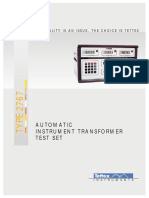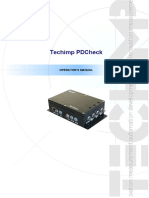PDI Vs NQN
PDI Vs NQN
Uploaded by
KUNALJAYCopyright:
Available Formats
PDI Vs NQN
PDI Vs NQN
Uploaded by
KUNALJAYOriginal Title
Copyright
Available Formats
Share this document
Did you find this document useful?
Is this content inappropriate?
Copyright:
Available Formats
PDI Vs NQN
PDI Vs NQN
Uploaded by
KUNALJAYCopyright:
Available Formats
Partial Discharge Integral Quantities
Partial discharge standards describe several integral quantities that commonly
are used to assess the level of partial discharge that is occurring in insulation.
These quantities and their definitions are about common across most of generic
PD standards.
Most frequently used integral quantities as per ASTM D1868 standard, for
example, are:
3.1.10 average discharge (corona) current (I
t
)the sum of the absolute magnitudes of the
individual discharges during a certain time interval divided by that time interval. When the
discharges are measured in coulombs and the time interval in seconds, the calculated current will
be in amperes.
0 1
3 2 1
1
0
...
t t
Q Q Q Q
I
t
t
n
t
+ + + +
=
where:
I
t
= average current, A,
t
0
= starting time, s,
t
1
= completion time, s, and
Q
1
, Q
2
, Q
n
= partial discharge quantity in a corona pulse 1 through n, C.
3.1.13 partial discharge (corona) power loss (P)the summation of the energies drawn from the
test voltage source by individual discharges occurring over a period of time, divided by that time
period.
When pulse height analysis is used, the summation over a period of time of pulses above a
preset level of corona usually determined by background noise multiplied by the instantaneous
test voltage at the time of the pulses in the specimen is approximately equal to:
=
=
i
j
j tj j
V Q n
T
P
1
) (
1
where:
P = pulse discharge power loss, W,
nj = recurrence rate of the jth discharge pulse in pulses/ second.
Qtj = the corresponding value of the partial discharge quantity in coulombs for the particular
pulse.
Vj = instantaneous value of the applied voltage in volts at which the jth discharge pulse takes
place.
3.1.14 partial discharge apparent power loss (Pa or PDI)the summation over a period of time of
all corona pulse amplitudes multiplied by the rms test voltage.
s t a
V I P =
where:
Pa = apparent power loss in time interval (t1 - t0), W,
It = average corona current, A, and
Vs = applied rms test voltage, V.
3.1.15 partial discharge (corona) pulse rate (n)the average number of discharge pulses that
occur per second or in some other specified time interval. The pulse count may be restricted to
pulses above a preset threshold magnitude, or to those between stated lower and upper
magnitude limits.
IEEE Guide of Measurement of Partial Discharges in Rotating Machinery 1434
defines an unique integral quantity called Normalized Quantity Number (NQN)
that is not presented in any other PD standard and is used specifically for rotating
machines.
Historically, this number was introduced by IRIS . By definition NQN originally
defined as the normalized area under a straight line fitted to the pulse counts in each magnitude
window of a pulse height analysis, where the pulse counts are expressed an a logarithm of the
pulses per second and the pulse magnitude window is a linear scale. Both the pulse magnitude
and repetition rate scales are normalized and the quantity obtained is divided by the gain of the
partial discharge detector. NQN can be represented mathematically as:
+ +
=
2
log
log
2
log
10
1
2
10
1 10 N
N
i
i
P
P
P
N G
FS
NQN
where P
I
= number of pulses per second in magnitude window i
N = number of magnitude windows
G = gain of the partial discharge detector
FS = maximum magnitude window in milli-volts at unity gain
Pulses with a high repetition rate have less of a contribution to the NQN than do pulses with low
repetition rate. It should be also noted that even if the normalizing process is followed, the value
of NQN for the same PD activity will vary as a function of the sensitivity of the PD detector and
thus the width and number of magnitude windows. Therefore a constant gain must be used if
various sets of pulse height analysis data are to be compared on the basis of NQN.
NQN, is to some extent, an attempt to represent the overall PD activity with a
single number. It should be noted that the more common Partial Discharge
Power Loss (P) or Apparent Power Loss (P
A
) representing actual energy
dissipation due to partial discharge serves this function.
As it is stated in the standard, NQN will vary significantly with a sensitivity of PD
detector and therefore NQN from different sensors or devices for the same PD
event can not be properly compared. For example, if you have a motor that
uses RFCTs on the surge capacitor grounding and wish to compare those results
to those on the same motor that uses 80 pF coupling capacitors, the data is not
comparable, even for the same PD event. If P
A
was used, this would not be the
case.
This is not the only problem with NQN. Even using the same PD detector and the
same instrument gain but varying number and size of magnitude windows and
maintaining the same magnitude range (FS), NQN will vary with magnitude
window.
The following example compares the relative variations in NQN and P
A
with a
change of magnitude and the number of magnitude windows for the same PD
event. Figure 1 shows the phase-resolved pulse height PD distribution and pulse
height distributions for positive negative and overall PD activity. Figure 2 shows
NQN and P
A
(positive, negative and overall) variation with magnitude window
size maintaining full scale (FS) at 1600mV. Magnitude window size was varied
from 10 to 200 mV and number of windows respectively from 160 to 8.
N(Q) Distribution
1
10
100
1000
10000
0 200 400 600 800 1000 1200 1400 1600
Q [mV]
N
[
p
p
s
]
N+ N- N
a. b. (Magnitude window at 100 mv)
Figure 1
NQN and PDI v.s. Magnitude Window Size
0
0.2
0.4
0.6
0.8
1
1.2
0 50 100 150 200
Magnitude Window [mV]
N
o
r
n
a
l
i
z
e
d
N
Q
N
a
n
d
P
D
I
NQN+ NQN- NQN PDI+ PDI- PDI
Figure 2
As can be seen from the Figure 2, an apparent power (PDI) maximum deviation
is for about 5% and PDI=(PDI+) + (PDI-). In the case of NQN, the variation is
about 3 times and NQN is not equal to (NQN+) + (NQN-).
The reason of all complications and problems with NQN is a use of a nonlinear
logarithmic operator applied to partial discharge pulse repetition rate. Therefore,
any linear operator can not be applied to NQN. A short list of issues are:
NQN data obtained with different PD sensors or instruments can not be
compared. Even a comparison with the same sensor and the same
instrument on different test objects may be incorrect due to possible different
sensor sensitivity on different objects. Sensitivity of a coupling capacitor
connected to a machine line terminals, for example, can very up to 2-3 times
depending upon a presence of a surge capacitor or a surge arrester, number
of cables, and the surge impedance of the cables and actual wiring inside a
terminal enclosure.
NQN does not allow flexibility in power frequency phase data analysis. This
means that NQN calculated over 180
0
phase range can not be compared in
any way to NQN calculated over 360
0
or 90
0
.
NQN does not allow for comparison of data taken at different full scales. In
other words, if pulse magnitude increased over time and one needs to use a
larger scale on PD analyzer, all previous data obtained at the lower scale is
not comparable to the current data. One should start the trend from the
beginning. (In our example above, the change of FS from 1600mV to 3200mV
maintaining 16 magnitude windows increases NQN by about 15% for the
same PD event.)
There is a difficulty in understanding the increase of PD with NQN. Lets
assume that PD pulse count increased twice in each magnitude window over
some time. NQN will reflect the increase as an addition to the existing NQN
that depends upon number of magnitude windows and their size. Lets
assume that maximum magnitude did not change and, therefore, FS factor,
window size, number of windows and gain are the same. In our example with
FS=1600mV and 16 magnitude windows the increase will be about 500.
Therefore, if initial NQN was 10 - the new one will be 510 (a 51 times
increase), but if initial NQN was 1,000 the new one will be 1,500 (50%
increase).
In conclusion, we recommend avoid NQN for all new PD technology users. Old
users should attempt switching to P and/or P
A
at all new measurements and also
to attempt recalculate older data to the same PD integral quantities for
comparison and trending purposes.
You might also like
- All New Classic 350 Service Manual Euro VDocument1,213 pagesAll New Classic 350 Service Manual Euro VItalo Marinho100% (1)
- Student Workbook For Murach's Mainframe COBOLDocument61 pagesStudent Workbook For Murach's Mainframe COBOLCarlos Alberto Chong Antonio75% (4)
- GPS Application Guide SDC ENDocument3 pagesGPS Application Guide SDC ENRoberto Amaral FurlaniNo ratings yet
- The Technology of Instrument Transformers: Current and Voltage Measurement and Insulation SystemsFrom EverandThe Technology of Instrument Transformers: Current and Voltage Measurement and Insulation SystemsNo ratings yet
- CP CR500 User ManualDocument44 pagesCP CR500 User ManualRaúl MendozaNo ratings yet
- Technical Guide ABB MV-Protection (EN) - 1VCP000280Document52 pagesTechnical Guide ABB MV-Protection (EN) - 1VCP000280Cesar VenturoNo ratings yet
- CT Testing Kit Tettex t2767-FcDocument8 pagesCT Testing Kit Tettex t2767-Fcdhanasekaran19731945No ratings yet
- 745 PDFDocument104 pages745 PDFPera100% (1)
- Method Statement For Partial Discharge Measurement: Application NoteDocument13 pagesMethod Statement For Partial Discharge Measurement: Application Notejmrs7322No ratings yet
- ABB Protection Application HandbookDocument356 pagesABB Protection Application HandbookSyed Muhammad Munavvar Hussain100% (1)
- CBSE Class 6 Maths Question Paper SA 1 2011Document3 pagesCBSE Class 6 Maths Question Paper SA 1 2011KUNALJAY100% (2)
- Lightning CalculationDocument14 pagesLightning Calculationpokiri86% (7)
- Bentley Continental GT by Mansory OverviewDocument17 pagesBentley Continental GT by Mansory OverviewBentley SpottingNo ratings yet
- Powapak Air Ultra Operating ManualDocument45 pagesPowapak Air Ultra Operating ManualBenrub Flores75% (4)
- MPD 600 Self Test: Application NoteDocument7 pagesMPD 600 Self Test: Application NoteInsan AzizNo ratings yet
- One Corner of The Delta TertiryDocument6 pagesOne Corner of The Delta TertiryaocalayNo ratings yet
- Arrester-Discharge-Counter-Tester 3KVDocument6 pagesArrester-Discharge-Counter-Tester 3KVrioNo ratings yet
- Info Iec60422 (Ed4.0) BDocument18 pagesInfo Iec60422 (Ed4.0) BDanny PeñaNo ratings yet
- Siemens: RELAY 7PA30 2-1AA00Document7 pagesSiemens: RELAY 7PA30 2-1AA00Mohamed WahidNo ratings yet
- How To Demagnitization in PTDocument8 pagesHow To Demagnitization in PTbcqbaoNo ratings yet
- Dielectric Response Analysis JDerecho PRESMATDocument20 pagesDielectric Response Analysis JDerecho PRESMATjaime100% (1)
- digiPHONE UG enDocument31 pagesdigiPHONE UG enHadi TNo ratings yet
- PDCheck User Manual - Rev08Document59 pagesPDCheck User Manual - Rev08anurag_jay12464100% (2)
- 8.6 MV Feeder Earth-Fault ProtectionDocument20 pages8.6 MV Feeder Earth-Fault Protectionbiviana81No ratings yet
- MPD Article How To Measure Partial Discharge 2020 ENUDocument2 pagesMPD Article How To Measure Partial Discharge 2020 ENUkashifNo ratings yet
- Article Ultrasonic or TevDocument2 pagesArticle Ultrasonic or Tevanchak99No ratings yet
- HVPD Longshot PD Mapping System User Manual Sep 2009Document37 pagesHVPD Longshot PD Mapping System User Manual Sep 2009navi_0403100% (1)
- Field Experience With Sweep Frequency Response Analysis For Power Transformer Diagnosis PDFDocument8 pagesField Experience With Sweep Frequency Response Analysis For Power Transformer Diagnosis PDFThien Nguyen VanNo ratings yet
- Ultratev Plus Operating Manual: Product Code: Utp2Document86 pagesUltratev Plus Operating Manual: Product Code: Utp2Hiếu Phan ThànhNo ratings yet
- CIGRE 2014 Paris Paper (B3-210) PD Monitoring System For HV SubstationsDocument13 pagesCIGRE 2014 Paris Paper (B3-210) PD Monitoring System For HV Substationsbmwr1100s_055542100% (1)
- CoreTec 4 - Transformer Monitoring PlatformDocument2 pagesCoreTec 4 - Transformer Monitoring PlatformJaime Vicuña CubillosNo ratings yet
- IPEC Webinar For India - Part 2 - HV Link Box MonitoringDocument29 pagesIPEC Webinar For India - Part 2 - HV Link Box MonitoringHafiziAhmadNo ratings yet
- Kries-Energietechnik Catalogue 8 2017 EDocument88 pagesKries-Energietechnik Catalogue 8 2017 EANTONIO SOLISNo ratings yet
- Decreasing Substation Failures With Ultrasound TechnologyDocument6 pagesDecreasing Substation Failures With Ultrasound TechnologyAnonymous Wu6FDjbNo ratings yet
- Brochure2010 en LDocument70 pagesBrochure2010 en Lbharat_22nandula100% (1)
- Testing of Potential Transformers PDFDocument6 pagesTesting of Potential Transformers PDFMuhammad asif100% (1)
- Single Core Cables in ParallelDocument1 pageSingle Core Cables in ParallelAamirMalik100% (1)
- IPEC Webinar For India - Part 1 - Partial Discharge OverviewDocument33 pagesIPEC Webinar For India - Part 1 - Partial Discharge OverviewHafiziAhmadNo ratings yet
- UTP MKII Product Training SlidesDocument65 pagesUTP MKII Product Training Slidesberkahharian100% (1)
- PowerPD Product SpecDocument29 pagesPowerPD Product SpecWiznu PraditamaNo ratings yet
- An Introduction To On-Line Partial Discharge (PD) Testing of Medium Voltage (MV) SwitchgearDocument13 pagesAn Introduction To On-Line Partial Discharge (PD) Testing of Medium Voltage (MV) SwitchgearHoang Thanh VanNo ratings yet
- PD Fault Location On Cable Lengths: Application NoteDocument17 pagesPD Fault Location On Cable Lengths: Application NoteInsan AzizNo ratings yet
- Urn100511 PDFDocument148 pagesUrn100511 PDFbabakfazelNo ratings yet
- Optical: Cts and VtsDocument7 pagesOptical: Cts and VtsmeraatNo ratings yet
- Inverter Modelling: 1 PurposeDocument23 pagesInverter Modelling: 1 PurposeLeonardo LeonNo ratings yet
- 7PG21 Solkor RF Technical Manual Chapter 6 Commissioning PDFDocument21 pages7PG21 Solkor RF Technical Manual Chapter 6 Commissioning PDFmarkgaloNo ratings yet
- 7pg21 Solkor R RF Catalogue SheetDocument26 pages7pg21 Solkor R RF Catalogue SheetsmcraftNo ratings yet
- 22kV GIS Cable Terminal - Installation ManualDocument11 pages22kV GIS Cable Terminal - Installation ManualNorma RetamozoNo ratings yet
- 1376 Rekaguide To Usefor52 145kvDocument26 pages1376 Rekaguide To Usefor52 145kvparthaNo ratings yet
- PR6100SA-005-A HVPD Kronos Monitor Product Presentation 22.05.2015 PDFDocument65 pagesPR6100SA-005-A HVPD Kronos Monitor Product Presentation 22.05.2015 PDFKhoilnNo ratings yet
- IEC 61936-1 BS EN 50522 EarthingDocument2 pagesIEC 61936-1 BS EN 50522 EarthingAnoop PrajapatiNo ratings yet
- 29 - Kim PD Measure and Monitoring On HV Cables PDFDocument4 pages29 - Kim PD Measure and Monitoring On HV Cables PDFbcqbaoNo ratings yet
- PD Measurement For HV Cable SystemDocument7 pagesPD Measurement For HV Cable SystemMichael Parohinog GregasNo ratings yet
- Dirana Anp 11002 EnuDocument24 pagesDirana Anp 11002 Enubcqbao100% (3)
- 3 Main Causes of False Differential Current in TransformerDocument14 pages3 Main Causes of False Differential Current in TransformerPandurang YadavNo ratings yet
- BS en 50181-2010Document16 pagesBS en 50181-2010Rylai CrestfallNo ratings yet
- Negative Dissipation Factor: IssueDocument4 pagesNegative Dissipation Factor: IssueBalu MNo ratings yet
- PD Testing and Monitoring of HV XLPE Cable Systems ENUDocument7 pagesPD Testing and Monitoring of HV XLPE Cable Systems ENUAnh Tuan NguyenNo ratings yet
- DownloadDocument13 pagesDownloadharigopalk12No ratings yet
- CSD100Document65 pagesCSD100HarshNo ratings yet
- Communication Training ReportDocument33 pagesCommunication Training ReportkakagoNo ratings yet
- Rapid Pressure Rise RelaysDocument4 pagesRapid Pressure Rise RelaysANGEL STRAGLIATINo ratings yet
- Line Drop CompensatorDocument7 pagesLine Drop CompensatorHéctor IbáñezNo ratings yet
- The Multichannel Analyzer: Physics 359EDocument5 pagesThe Multichannel Analyzer: Physics 359EShella SeptianiNo ratings yet
- T 7.2.1.1 Multiplicación de FrecuenciaDocument40 pagesT 7.2.1.1 Multiplicación de FrecuenciaBlademir Parra GayosoNo ratings yet
- Vacuum Interrupter Tester: VidarDocument3 pagesVacuum Interrupter Tester: VidarKUNALJAYNo ratings yet
- The Kakas of New ZealandDocument3 pagesThe Kakas of New ZealandKUNALJAYNo ratings yet
- On Line Energy Conservation System: K.R. Nerkar GM (Electrical)Document47 pagesOn Line Energy Conservation System: K.R. Nerkar GM (Electrical)KUNALJAYNo ratings yet
- AccessoriesDocument56 pagesAccessoriesKUNALJAYNo ratings yet
- Scot M3K-MXP PDFDocument2 pagesScot M3K-MXP PDFKUNALJAYNo ratings yet
- Vacuum Interrupter Tester: VidarDocument3 pagesVacuum Interrupter Tester: VidarKUNALJAYNo ratings yet
- Overview Bearing Types PDFDocument9 pagesOverview Bearing Types PDFKUNALJAYNo ratings yet
- Digital ExciterDocument80 pagesDigital ExciterKUNALJAY100% (2)
- Abb Excitation 1Document45 pagesAbb Excitation 1Erbil Keskin100% (1)
- 3882 1 SipolCatalogueDocument12 pages3882 1 SipolCatalogueAlfonso Núñez SchorrNo ratings yet
- Motor TestingDocument26 pagesMotor TestingGas Gas Ducati100% (1)
- Use of Coal Blending Process - A Case Study of Dahanu TPSDocument12 pagesUse of Coal Blending Process - A Case Study of Dahanu TPSKUNALJAYNo ratings yet
- Low Volatile Doosan BabcockDocument22 pagesLow Volatile Doosan BabcockKUNALJAY100% (1)
- Advantages of Low Volatile Coals For PCIDocument24 pagesAdvantages of Low Volatile Coals For PCIKUNALJAYNo ratings yet
- Combustion Characteristics of Low Grade Coal And: Principal Research ResultsDocument2 pagesCombustion Characteristics of Low Grade Coal And: Principal Research ResultsKUNALJAYNo ratings yet
- Netherlend Coal BlendingDocument7 pagesNetherlend Coal BlendingKUNALJAYNo ratings yet
- DG43NB Product BriefDocument4 pagesDG43NB Product Briefign_handokoNo ratings yet
- GF - Installation Instructions For FlangesDocument6 pagesGF - Installation Instructions For FlangesHafiz KamalNo ratings yet
- GAPS Guidelines: PrefaceDocument1 pageGAPS Guidelines: Prefacenastyn-1No ratings yet
- Specification FOR 53gradeordinaryportlandcement: Indian StandardDocument20 pagesSpecification FOR 53gradeordinaryportlandcement: Indian StandardVivekChaudharyNo ratings yet
- Civil Engineer ResumeDocument1 pageCivil Engineer ResumeMost koliNo ratings yet
- Safety Audits EbookDocument12 pagesSafety Audits EbookMalappareddyNo ratings yet
- Sika Backing FillerDocument2 pagesSika Backing Fillerthe pilotNo ratings yet
- High Voltage Live Work Procedures Distribution Insulated Stick 2015 05Document144 pagesHigh Voltage Live Work Procedures Distribution Insulated Stick 2015 05Pedro Sarmiento100% (1)
- CSE SyllabusDocument9 pagesCSE SyllabusSathyam RajpalNo ratings yet
- TKSA 80 Alineador LaserDocument4 pagesTKSA 80 Alineador LaserdayrNo ratings yet
- MGMTEffective Assessment of Onboard SituationsDocument11 pagesMGMTEffective Assessment of Onboard SituationstiukristiannicolasNo ratings yet
- Guide For Determining The Emissions Classes of Heavy Commercial VehiclesDocument4 pagesGuide For Determining The Emissions Classes of Heavy Commercial VehiclesAnonymous LJ1v8KKNo ratings yet
- Group 8 Report Hardware IronmongeryDocument52 pagesGroup 8 Report Hardware IronmongeryLysa BeltranNo ratings yet
- Ansys Manual CombinesDocument240 pagesAnsys Manual CombinesNo ShieelaNo ratings yet
- OMC Installation GuideDocument61 pagesOMC Installation GuideabubakrNo ratings yet
- StokDocument58 pagesStokYuraditya AtharayhanNo ratings yet
- Wi-Fi Networks 2023-06-28-14-44-39Document3 pagesWi-Fi Networks 2023-06-28-14-44-39Michal PuskasNo ratings yet
- The Role of A Construction ManagerDocument9 pagesThe Role of A Construction Managermy_sydgal100% (1)
- Supplier Document Cover Sheet: RNP DCU Plant ProjectDocument12 pagesSupplier Document Cover Sheet: RNP DCU Plant ProjectSlobodan MilosavljevicNo ratings yet
- Chap5 Gas Reticulation SystemDocument188 pagesChap5 Gas Reticulation SystemNorafiqah Ismail100% (3)
- Stok Status ReportDocument52 pagesStok Status ReportRISKA.SILVIANo ratings yet
- Advantest R6441aDocument3 pagesAdvantest R6441aangelo_lopez1993No ratings yet
- Magic Deluxe Redesign ManualDocument16 pagesMagic Deluxe Redesign ManualG.H.No ratings yet
- Sathyamangalam: (Repeat The Three Steps For 8 Times)Document8 pagesSathyamangalam: (Repeat The Three Steps For 8 Times)palanisamyam123No ratings yet
- SANS1200LDocument17 pagesSANS1200LNiyazudeen VakilNo ratings yet










































































































